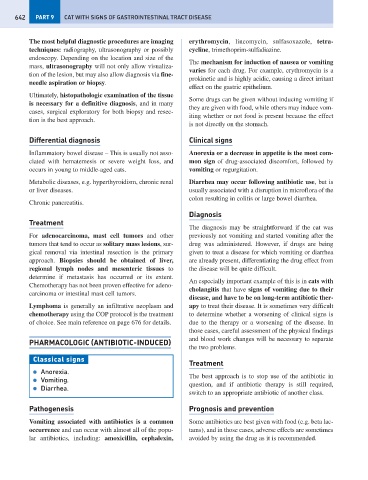Page 650 - Problem-Based Feline Medicine
P. 650
642 PART 9 CAT WITH SIGNS OF GASTROINTESTINAL TRACT DISEASE
The most helpful diagnostic procedures are imaging erythromycin, lincomycin, sulfasoxazole, tetra-
techniques: radiography, ultrasonography or possibly cycline, trimethoprim-sulfadiazine.
endoscopy. Depending on the location and size of the
The mechanism for induction of nausea or vomiting
mass, ultrasonography will not only allow visualiza-
varies for each drug. For example, erythromycin is a
tion of the lesion, but may also allow diagnosis via fine-
prokinetic and is highly acidic, causing a direct irritant
needle aspiration or biopsy.
effect on the gastric epithelium.
Ultimately, histopathologic examination of the tissue
Some drugs can be given without inducing vomiting if
is necessary for a definitive diagnosis, and in many
they are given with food, while others may induce vom-
cases, surgical exploratory for both biopsy and resec-
iting whether or not food is present because the effect
tion is the best approach.
is not directly on the stomach.
Differential diagnosis Clinical signs
Inflammatory bowel disease – This is usually not asso- Anorexia or a decrease in appetite is the most com-
ciated with hematemesis or severe weight loss, and mon sign of drug-associated discomfort, followed by
occurs in young to middle-aged cats. vomiting or regurgitation.
Metabolic diseases, e.g. hyperthyroidism, chronic renal Diarrhea may occur following antibiotic use, but is
or liver diseases. usually associated with a disruption in microflora of the
colon resulting in colitis or large bowel diarrhea.
Chronic pancreatitis.
Diagnosis
Treatment
The diagnosis may be straightforward if the cat was
For adenocarcinoma, mast cell tumors and other previously not vomiting and started vomiting after the
tumors that tend to occur as solitary mass lesions, sur- drug was administered. However, if drugs are being
gical removal via intestinal resection is the primary given to treat a disease for which vomiting or diarrhea
approach. Biopsies should be obtained of liver, are already present, differentiating the drug effect from
regional lymph nodes and mesenteric tissues to the disease will be quite difficult.
determine if metastasis has occurred or its extent.
An especially important example of this is in cats with
Chemotherapy has not been proven effective for adeno-
cholangitis that have signs of vomiting due to their
carcinoma or intestinal mast cell tumors.
disease, and have to be on long-term antibiotic ther-
Lymphoma is generally an infiltrative neoplasm and apy to treat their disease. It is sometimes very difficult
chemotherapy using the COP protocol is the treatment to determine whether a worsening of clinical signs is
of choice. See main reference on page 676 for details. due to the therapy or a worsening of the disease. In
those cases, careful assessment of the physical findings
and blood work changes will be necessary to separate
PHARMACOLOGIC (ANTIBIOTIC-INDUCED)
the two problems.
Classical signs
Treatment
● Anorexia.
The best approach is to stop use of the antibiotic in
● Vomiting.
question, and if antibiotic therapy is still required,
● Diarrhea.
switch to an appropriate antibiotic of another class.
Pathogenesis Prognosis and prevention
Vomiting associated with antibiotics is a common Some antibiotics are best given with food (e.g. beta lac-
occurrence and can occur with almost all of the popu- tams), and in those cases, adverse effects are sometimes
lar antibiotics, including: amoxicillin, cephalexin, avoided by using the drug as it is recommended.

